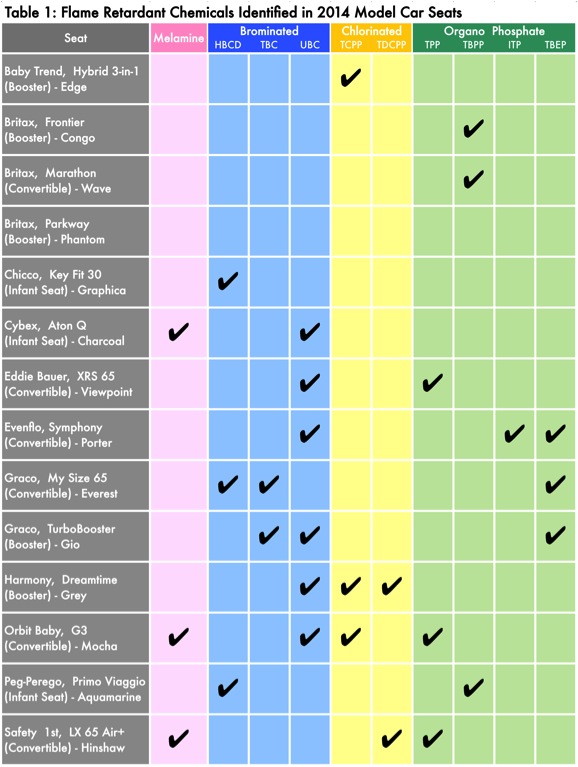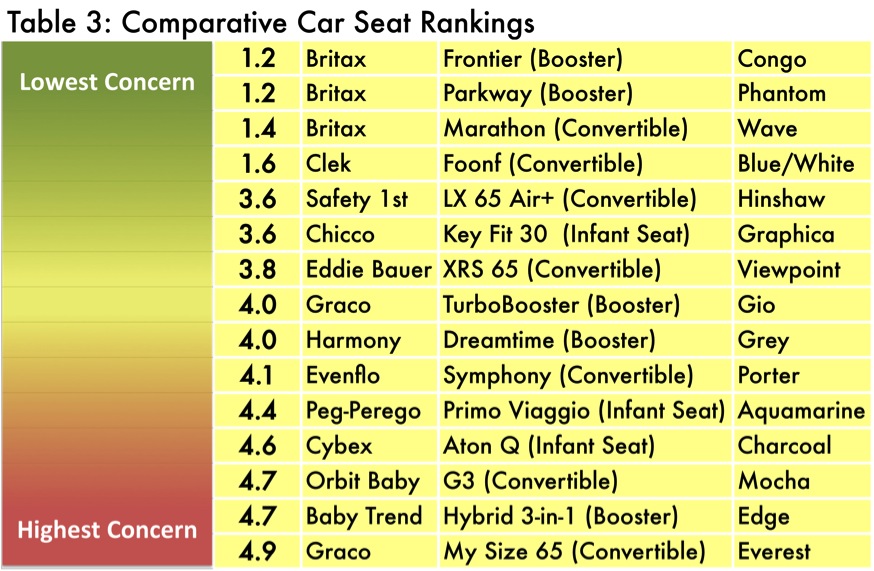Overview and Consumer Guide
Always Use a Car Seat
Car seats keep our children safely restrained during travel. All car seats on the market must meet current standards for crash safety. Car seats should only be used during travel, as infants left in car seats outside of the car are at greater risk for falling from an elevated surface and for airway obstruction. They also face potentially increased exposure to hazardous chemicals from the seat. When traveling, however, children must be secured in a car seat.
Chemicals used as Flame Retardants are Hazardous to Human Health
In the 1970’s, a chemical known as chlorinated tris, or TDCPP, was used to treat children’s pajamas to make the fabric slower to catch fire. Chlorinated tris was a replacement for the mutagenic and carcinogenic chemical TDBPP that preceded it. However, TDCPP was revealed as a carcinogen as well and was removed from pajamas.
Unfortunately, TDCPP made a comeback after another toxic class of flame retardants called PBDEs were largely phased out in 2004. Manufacturers began using TDCPP as a replacement for PBDEs in furniture, car interiors, tents, and children’s products such as nap mats and crib pads (but not pajamas). It was also found in two of the 2014 model car seats in our new study. Not surprisingly, researchers began measuring the chemical in the bodies of infants, children, and adults.
The story of TDCPP highlights the challenge consumers face in trying to buy safe products for their children and themselves. United States flammability regulations for car interiors and accessories—including car seats—cause manufacturers to add hazardous chemicals to their products. When one chemical is banned, another is used—and the replacement is sometimes no safer.
Children are especially vulnerable to the harmful effects of toxic chemicals because their bodies are developing, and because pound for pound, they eat, drink, and breathe about two and a half times more than adults. They also consume more household dust, which routinely contains contaminants like flame retardant chemicals. Many of these chemicals can harm the nervous system, cause cancer, and/or disrupt the hormone (endocrine) system.
According to our laboratory research and discussion with car seat companies, all car seats contain at least one chemical flame retardant in order to meet the federal fire test standard for vehicle accessories. Most flame retardant chemicals can be divided into three classes: Brominated, chlorinated, and phosphate-based. Brominated and chlorinated chemicals are also called halogenated. Some manufacturers, such as Britax and Clek, have moved away from halogenated flame retardants due to their toxicity and extreme persistence in the environment. The replacements are typically halogen-free phosphate chemicals. According to limited research studies, some of these replacements may be safer for human health, while others may be harmful. Read more about these specific chemicals in our full Technical Report.
Due to their widespread use in everyday consumer products, flame retardant chemicals are rapidly accumulating inside of our bodies and in soil and water—such as the Great Lakes—all over the globe. The chemicals have been repeatedly detected in Arctic air, indicating that they travel long distances. These chemicals pose health concerns particularly for infants, children and pregnant women. Biomonitoring, or testing for chemical accumulation in people, has detected multiple flame retardants in virtually every human tested, including newborn babies.
Added flame retardant chemicals are not bound to the car seat materials and thus are released over time. Infants, toddlers and children can be exposed through inhalation, ingestion and dermal (skin) absorption of these chemicals. The main route of exposure depends on the particular chemical.
Many children spend hours in a car every week, or even every day, potentially exposing them to harmful intakes of flame retardants. Babies and toddlers also spend large amounts of time on the floor and are thereby highly exposed to household dust. Breathing and eating dust particles containing flame retardant chemicals are major avenues of exposure.
But…Do chemical flame retardants protect children from fire?
Unfortunately, analyses of real-world vehicle fire scenarios suggest that flame retardant chemicals in car seats are unlikely to keep a child safer in a fire. The speed with which an engine fire fills the cabin with smoke and then flames, coupled with typical emergency response times, can make the brief delay in ignition from chemical flame retardants inadequate. To improve fire safety without adding even more chemicals, we urge car manufacturers to re-design certain parts of the vehicle to reduce fire hazards in the cabin. Read more about non-toxic fire safety in our Technical Report.
HealthyStuff.org’s 2015 Car Seat Results (2014 Model Seats)
Since 2006, HealthyStuff.org has tested 377 car seats. The older seats were tested primarily for heavy metals and the general class of brominated flame retardants, whereas the newest sample set (2014 models) was tested to identify a variety of specific flame retardant (FR) chemicals.
For this Report, HealthyStuff.org tested fifteen car seat models representing twelve brands, all manufactured in 2014, for potentially hazardous chemicals. We focused on the components of the seats likely to contain FR chemicals: polyurethane foam, expanded polystyrene or expanded polypropylene foam, and polyester textiles.
The results for fourteen of the seats are shown in Table 1. (The remaining seat, Clek Foonf, was received late and tested for a smaller number of chemicals. The Foonf tested negative for PBDEs, HBCD, and several forms of chlorinated tris.) Almost every car seat tested contained one or more known flame retardant chemicals. No known FR chemicals were detected in the Britax Parkway, but all Britax car seats, according to our communication with the company, do contain a phosphate-based flame retardant. The Parkway likely contains a novel FR that our analytical method could not identify.
So, what do the results in Table 1 mean? Which chemicals are more harmful or less harmful? These are not easy questions to answer because many of the flame retardant chemicals identified in the 2014 car seats have been inadequately studied for their potential health effects. Table 2 gives a brief overview of the health concerns for each of the FR chemicals detected, based on available research studies. The shading color corresponds to FR class: melamine (pink), brominated FRs (blue), chlorinated organophosphates (yellow), and halogen-free phosphates (green). We expect the information in Table 2 to be refined and updated over time.
A piece of good news is that no PBDEs were found in our sample set. PBDEs are toxic brominated FR chemicals that were widely used for decades before 2005.
Although PBDEs were not detected, we found other brominated chemicals in almost two-thirds of the tested car seats. These brominated replacements have potential health risks of their own and are, like PBDEs, highly persistent in the environment.
Chlorinated flame retardants were detected in 29% of the tested seats. These also have serious health hazards and build up in living organisms, including people.
Almost two-thirds of the tested seats contained halogen-free, phosphate-based flame retardants. Although eliminating halogens is expected to be a beneficial trend, and we commend the companies (Clek and Britax) that have eliminated brominated and chlorinated chemicals, we caution that some of the phosphates also show evidence of serious health hazards.
Based on our test results, we rated each seat for chemical hazard potential in comparison to the other tested seats. While no seat was without any flame retardant chemical, some contained chemicals that are more hazardous than others. The ratings, shown in Table 3, are intended to help consumers choose among an imperfect field to buy a product that is essential for children.
Company Highlight: Britax
Not long ago, Britax car seats, like most others on the market, contained high levels of brominated and antimony-based flame retardants, and even toxic lead. HealthyStuff.org’s testing prompted the company to take notice. Britax made a commitment to manufacture less toxic car seats, and since then, Britax car seats have improved substantially. The company’s internal policy now restricts over 100 chemicals, such as phthalates, metals, brominated and chlorinated flame retardants, and antimony compounds.
HealthyStuff.org tested three 2014 Britax seats, and while they do rely on phosphate-based flame retardants with uncertain toxicity profiles to meet federal flammability requirements, they’ve come a long way in minimizing chemicals of concern.
Read more about the Britax story in our Technical Report.
What’s a parent to do?
Here’s our advice regarding car seats and the car environment as a whole—because every surface and material in the car itself is likely coated or infused with flame retardant chemicals.
- Contact the car seat companies. Let them know you expect them to manufacture products without toxic chemicals, which threaten the health of our children and natural resources. Car seat companies need to hear from people like you. They need to know we are tired of toxic chemicals being added to our children’s products, and demand safer, healthier options.
- Limit the time your children spend in their car seats. Only use the car seat during travel, not as a place for your child to nap or sit outside of the car.
- Limit direct sunlight on the car seat and high temperatures in your car. Flame retardants and other hazardous chemicals may be released at a higher rate when your car becomes hot. When possible, park in the shade or in covered parking. Window coverings in a car also substantially lower the interior temperature on a warm day.
- Vacuum the car interior and the nooks and crannies of car seats. Chemicals that migrate out, including flame retardants, can cling to dust particles. Open the car windows when possible.
- If you’re looking to purchase a car seat, we suggest you look for companies that have comprehensive chemical policies—ask if you can’t find the information easily—or a system to prioritize reduction and elimination of toxic chemicals in their products. Companies that sell children’s products should publicly disclose these policies. While HealthyStuff.org cannot test every car seat for every chemical of concern, here’s our general advice: buy the safest car seat you can afford and use it only for travel, support companies that publicly prioritize healthier, non-toxic products and, most importantly, enjoy your journey through parenthood!
What should companies do?
- HealthyStuff.org urges companies to prioritize the manufacturing of safer, healthier products by adopting the Five Essential Practices for Retailers, Brand Owners and Suppliers. These five practices emphasize company-wide policies on reducing hazardous chemicals in their products, chemical disclosure to consumers, as well as phasing out the most toxic chemicals and transitioning to safer alternatives.
- Companies who adopt these five essential practices are likely to bolster their consumers’ confidence, trust and loyalty to their products. Consumers, especially parents, are demanding safer, healthier options for their families. Companies can capitalize on this demand by adopting these five essential practices and ensuring their products are free from the most toxic chemicals.
- With regard to chemical flame retardants, we urge companies to choose the least toxic options available, to use as little as needed to meet the fire test standard, and to re-evaluate the materials and added chemicals in their seats on a regular basis as new research becomes available.
- We further suggest that companies design the seat covers on car seats to be easily removed for laundering. Washing the covers can remove contaminated dust and other particles. Most current car seats must be significantly dismantled in order to remove the covers, making regular laundering impractical.





